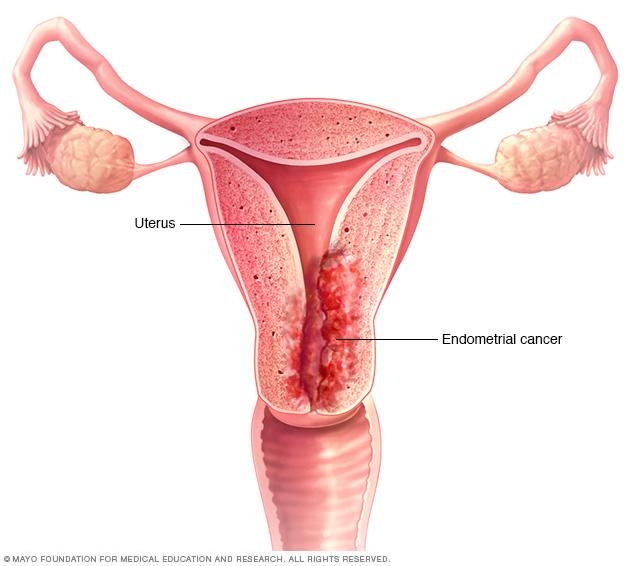
- Origin: Starts in the lining of the uterus (endometrium), most common after menopause.
- Main Symptom: Abnormal vaginal bleeding, especially postmenopausal.
- Risk Factors: Includes obesity, excess estrogen, diabetes, and Lynch syndrome.
- Treatment: Involves surgery (hysterectomy), radiation, hormone therapy, and chemotherapy depending on the stage.
Endometrial Cancer: In-Depth Overview
Endometrial cancer is a type of cancer that begins in the endometrium, the inner lining of the uterus (womb). It is the most common type of uterine cancer, often affecting postmenopausal women. Most cases are diagnosed early because abnormal vaginal bleeding is a common and easily noticeable symptom.
🧬 Causes and Risk Factors
Endometrial cancer usually results from hormonal imbalances, especially excess estrogen without enough progesterone, which causes the endometrial lining to thicken excessively. Over time, this can lead to abnormal cells and eventually cancer.
Key Risk Factors:
- Age: Most common in women aged 50 and above (postmenopausal).
- Obesity: Fat tissue increases estrogen levels, which raises the risk.
- Hormone Therapy: Estrogen-only hormone replacement therapy increases risk.
- Polycystic Ovary Syndrome (PCOS): Leads to hormonal imbalance.
- Diabetes and hypertension: Often linked with obesity and increase the risk.
- Early menstruation or late menopause: Longer lifetime exposure to estrogen.
- Nulliparity: Women who have never been pregnant have a higher risk.
- Family history or genetic syndromes: Such as Lynch syndrome (HNPCC).
📊 Types of Endometrial Cancer
- Type I (Endometrioid Adenocarcinoma):
- Most common form (about 80%).
- Often hormone-sensitive and slow-growing.
- Usually detected at an early stage.
- Type II (Non-endometrioid):
- Includes serous carcinoma and clear cell carcinoma.
- More aggressive, not related to estrogen, and often diagnosed at a later stage.
⚠️ Signs and Symptoms
Symptoms often appear early, making the cancer easier to detect and treat:
- Abnormal vaginal bleeding (especially after menopause)
- Pelvic pain or pressure
- Unusual vaginal discharge
- Pain during intercourse
- Weight loss (in advanced stages)
Postmenopausal bleeding is the most common warning sign and should always be evaluated by a doctor.
🔬 Diagnosis
- Pelvic Exam: To feel for abnormalities in the uterus.
- Transvaginal Ultrasound (TVUS): Measures the thickness of the endometrial lining.
- Endometrial Biopsy: The most accurate test—samples endometrial tissue for cancer cells.
- Hysteroscopy: A scope is used to view the uterus and take a biopsy.
- Dilation and Curettage (D&C): If a biopsy is inconclusive, a more thorough scraping of the uterine lining is done.
🩺 Staging of Endometrial Cancer
Cancer is staged based on how far it has spread:
- Stage I: Confined to the uterus.
- Stage II: Spread to the cervix.
- Stage III: Spread to nearby tissues or lymph nodes.
- Stage IV: Spread to distant organs (e.g., bladder, rectum, lungs).
💉 Treatment Options
Treatment depends on the stage, grade, and type of cancer.
- Surgery:
- Total Hysterectomy (removal of uterus and cervix)
- Bilateral Salpingo-oophorectomy (removal of ovaries and fallopian tubes)
- May include lymph node dissection for staging.
- Radiation Therapy:
- Used post-surgery to prevent recurrence or as primary treatment in inoperable cases.
- Includes external beam radiation and brachytherapy (internal radiation).
- Hormone Therapy:
- Uses progestins to slow cancer growth, especially for hormone-sensitive cancers.
- Useful for women who cannot undergo surgery or want to preserve fertility.
- Chemotherapy:
- Used for advanced or aggressive types (Type II), or when cancer has spread.
- Common drugs: Carboplatin, Paclitaxel, Doxorubicin.
- Targeted Therapy and Immunotherapy:
- Newer treatments like Pembrolizumab (an immunotherapy drug) are being used for advanced or recurrent endometrial cancer with certain genetic markers.
🔄 Prognosis
- Early-stage endometrial cancer has an excellent prognosis, with a 5-year survival rate of about 95% for Stage I.
- Survival drops for advanced stages: around 69% for Stage III and 17% for Stage IV.
🛡️ Prevention and Screening
There is no routine screening for endometrial cancer, but risk can be reduced by:
- Maintaining a healthy weight
- Using birth control pills (they reduce the risk by balancing hormones)
- Treating hormonal disorders like PCOS
- Managing diabetes and hypertension
- Reporting abnormal bleeding early
- Genetic counseling for those with a family history or Lynch syndrome
✅ Conclusion
Endometrial cancer is one of the most treatable gynecologic cancers when detected early. Awareness of symptoms—especially abnormal vaginal bleeding—and prompt medical evaluation are key to early diagnosis. Advances in surgery, radiation, and newer therapies are improving survival and quality of life.
Would you like a short summary in 4 points as well?

